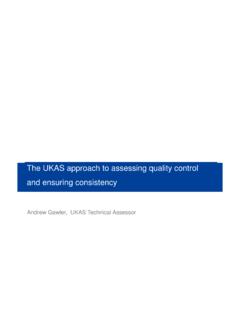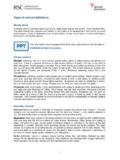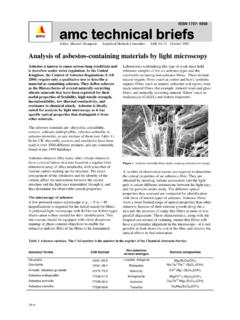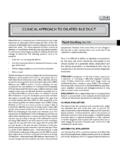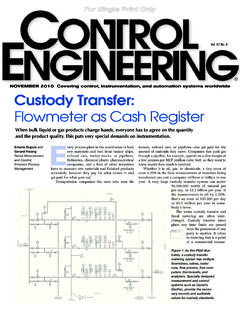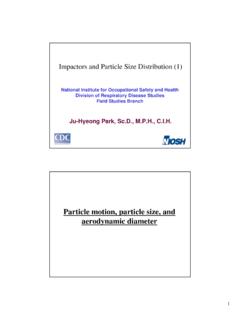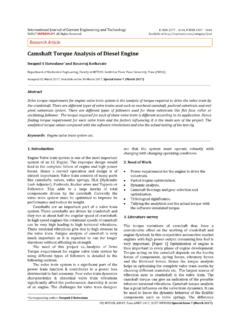Transcription of Guide to achieving reliable quantitative LC-MS …
1 Guide to achieving reliable quantitative LC-MS measurements Guide to achieving reliable quantitative LC-MS measurements RSC Analytical Methods Committee First Edition 2013 Editor Mike Sargent Contributors Ashley Sage Celine Wolff Chris Mussell David Neville Gwyn Lord Mansoor Saeed Rakesh Lad Ruth Godfrey Simon Hird Vicki Barwick Acknowledgements This Guide has been prepared with the assistance of members of the AMC mass Spectrometry Sub-Committee. Publication of the draft Guide with minor corrections was approved by the AMC at its meeting on 15 November 2013. Production of this Guide was in part funded by the UK National Measurement System. We are grateful to Agilent Ltd for permission to reproduce Figures , and Gareth Brenton for Figure This publication should be cited as: M.
2 Sargent (Ed.), Guide to achieving reliable quantitative LC-MS measurements, RSC Analytical Methods Committee, 2013. ISBN 978-0-948926-27-3. First Edition 2013 ISBN 978-0-948926-27-3 Copyright LGC Limited 2013 quantitative LC-MS Guide , 1st Ed. 2013 Page i Preface mass spectrometry (MS) has the capability to separate organic molecules according to their molecular mass and permits their detection and quantitation with extremely high sensitivity. High performance liquid chromatography (HPLC) facilitates the rapid, quantitative separation of compounds from each other and from the other constituents of complex mixtures or matrices. Used in tandem, the two techniques (usually referred to as LC-MS ) provide a unique capability for rapid, cost-effective and quantitative measurements of organic molecules for an enormous variety of applications.
3 Routine use of mass spectrometry began to grow in the 1950s, followed by HPLC in the 1970s. However, development of reliable interfaces to link the two techniques was not easy and it is only during the past twenty or so years that LC-MS has assumed the key role it occupies today. During that time, manufacturers have succeeded in steadily reducing the size and real cost of the instrumentation whilst software and automation have greatly lowered the learning curve for operators. As a result, LC-MS has become ubiquitous as the technique of choice for many quantitative analysis applications. Appearances can, however, be deceptive. Whilst there is no question that modern LC-MS instruments are relatively easy to operate and maintain, there are also many pitfalls awaiting the unwary, especially for accurate quantitative measurement of analytes at trace concentrations or in complex samples.
4 The problem is exacerbated by the apparent ease with which the technique can be applied to ever more demanding applications and the understandable tendency of manufacturers to emphasize the benefits of their products. In this LC-MS Guide we have attempted to bring together practical advice which we hope will assist users of the technique to avoid many common problems and to develop reliable , quantitative applications as quickly and cheaply as possible. The Guide is not a textbook so readers will find little discussion of theoretical aspects of the techniques. Similarly, we have limited descriptions of the instrumentation to key aspects which we feel are necessary for readers to benefit from the many hints and tips given in the practical advice. Two aspects of the guidance merit further comment.
5 First, achieving reliable quantitation by LC-MS depends not only on correct use of the instrumentation but also on correct development and use of the entire analytical method. We have, therefore, included extensive advice on aspects such as sample preparation and calibration strategies. Secondly, experience shows that many errors in analytical data result not from lack of understanding of the measurement techniques but as a result of simple and avoidable mistakes during their application. Such matters are addressed in many textbooks and guides on quality assurance but we have provided a very brief overview of some common issues. In keeping with the practical approach of this Guide , we have also offered a few common sense suggestions to help readers ensure that the time and effort spent on developing a reliable LC-MS method is not wasted by making avoidable errors during its routine use.
6 Mike Sargent Chair, AMC mass Spectrometry Sub-Committee December 2013 quantitative LC-MS Guide , 1st Ed. 2013 Page ii Contents 1 Introduction .. 1 Scope of this Guide .. 1 Why Use LC-MS for quantitation? .. 2 Matrix effects (or ion suppression) .. 3 The key stages of quantitative analysis .. 3 Sample collection .. 3 Calibration and quality control samples .. 3 Sample preparation and extraction .. 3 Analysis .. 4 Data processing .. 4 Reporting .. 4 References and further reading .. 4 2 Instrumentation .. 5 The ion source .. 7 Electrospray ionisation (ESI).. 8 Atmospheric pressure chemical ionisation (APCI) .. 9 The mass analyser .. 9 Tandem mass spectrometry .. 9 High resolution mass spectrometry .. 10 3 Method development and 12 Research and planning.
7 12 MS initial tuning .. 13 Chromatography development .. 13 MS optimisation .. 13 Sensitivity assessment .. 14 Sample preparation and extraction .. 14 Matrix effects .. 14 Post-column infusion .. 14 Post-extraction spike .. 15 Extent of development .. 15 Evaluation of the method .. 15 References and further reading .. 15 4 Sample preparation .. 16 General considerations of sample preparation .. 16 Liquid-liquid extraction (LLE) .. 17 Partition ratio (K) [15] .. 17 Extraction procedure .. 18 Practical considerations .. 18 Protein 20 Solid phase extraction (SPE) .. 20 SPE protocols .. 20 Practical SPE considerations .. 22 Sample preparation kits .. 24 References and further reading .. 25 5 Selection and optimisation of the chromatographic system.
8 27 Key chromatographic parameters impacting on quantification using LC-MS /MS .. 27 Retention factor (k) .. 27 Selectivity ( ) .. 28 Column efficiency (N) .. 28 Resolution (Rs) .. 28 Tips for selection of conditions .. 28 Column .. 29 Mobile phase for reversed-phase (RP) chromatography .. 30 Suggested initial conditions .. 31 Column .. 31 quantitative LC-MS Guide , 1st Ed. 2013 Page iii Mobile phase .. 31 Injection mode .. 31 Elution methods .. 31 Troubleshooting .. 32 Retention capacity .. 32 Selectivity .. 32 Carry over and contamination .. 33 References and further reading .. 34 6 Optimisation of the LC-MS interface and mass spectrometer .. 35 Key mass spectrometric parameters impacting on quantification using LC-MS /MS .. 36 The nebulisation process.
9 36 The desolvation process .. 36 mass analyser parameters for selected reaction monitoring (SRM) .. 36 Considerations before starting optimisation .. 36 Preparation for the optimisation procedure .. 37 Choice of solvent .. 37 Introduction of standard solutions .. 38 Other considerations .. 38 Procedure for optimisation .. 39 Optimisation of the nebulisation process .. 40 Potential difference between the electrospray capillary and a counter electrode .. 40 The nebuliser gas flow .. 40 Sprayer position relative to the sampling orifice .. 40 The eluent composition and flow rate .. 41 Optimisation of the desolvation process .. 41 Source temperature .. 41 Drying/desolvation temperature and gas flows .. 41 Declustering .. 41 Optimisation of mass analyser parameters for selected reaction monitoring (SRM).
10 42 mass resolution and calibration .. 42 Collision energy, gas flow and associated voltages .. 42 Optimisation of data acquisition settings .. 42 7 Calibration .. 44 Selection of calibration standards .. 44 Preparation and storage of calibration solutions .. 45 Calibration 45 Matrix matched external calibration .. 46 Standard addition internal calibration .. 46 Internal calibration by direct addition .. 46 Selection and use of internal standards .. 47 General considerations .. 47 Use of isotopically labelled internal standards .. 47 Calibration data reduction .. 48 References and further reading .. 49 8 Method validation and uncertainty .. 50 Method validation .. 50 Measurement uncertainty .. 51 Evaluating measurement uncertainty .. 52 Use of uncertainty information in developing and improving methods.
